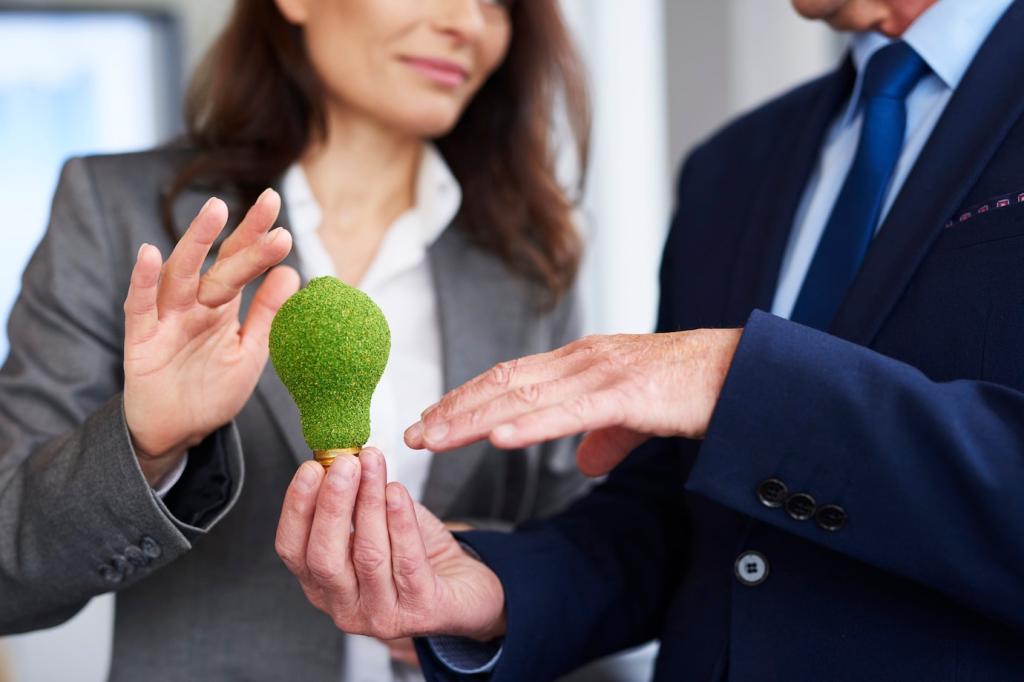Eco-Friendly Smart Home Innovations
Discover how modern technology and sustainable design principles are merging to redefine the concept of home living. Eco-friendly smart home innovations are not just about convenience—they are about building a future where energy efficiency, comfort, and ecological responsibility thrive together. Explore the cutting-edge advancements making homes safer for people and better for the planet.

Smart Grid Integration
Smart grid integration allows homes to communicate directly with the broader energy network, drawing electricity during off-peak hours and sending excess energy from solar panels back to the grid. This two-way relationship ensures optimal efficiency, supports renewable energy use, and provides homeowners with real-time feedback about their consumption. Over time, this reduces reliance on non-renewable resources and helps stabilize energy costs community-wide.

Adaptive Power Controls
Adaptive power control systems use data from sensors and learning algorithms to adjust lighting, heating, and cooling based on occupancy, weather, and even the time of day. These technologies eliminate unnecessary energy use by responding to real-world conditions, ensuring that devices and appliances operate only when needed. The outcome is a more sustainable, streamlined, and cost-effective living environment that benefits both homeowners and the planet.

Renewable Energy Integration
Incorporating solar panels, wind turbines, and battery storage, renewable energy integration solutions help homeowners generate, store, and use clean energy efficiently. By coordinating with smart inverters and energy management software, these solutions maximize self-consumption and minimize dependence on the traditional grid. As technology advances, these systems become increasingly accessible, contributing significantly to reducing household carbon footprints.
Sustainable Building Materials
Utilizing recycled and upcycled components in home construction reduces waste, conserves natural resources, and supports a circular economy. Innovative materials derived from plastic bottles, reclaimed wood, and industrial by-products undergo strict processing to maintain durability and safety standards. As a result, they provide eco-conscious alternatives to traditional construction materials, ensuring that smart homes are not just technologically advanced but also environmentally sound at their core.

Water Conservation Technologies
Intelligent Leak Detection
Smart leak detection devices use sensors, connectivity, and artificial intelligence to pinpoint plumbing issues as soon as they arise, often before any visible damage occurs. These systems notify homeowners instantly, enabling rapid response to potential leaks. In doing so, they prevent water waste, lessen the chance of structural damage, and contribute to a proactive approach to home maintenance and environmental stewardship.
Smart Irrigation Systems
By integrating weather forecasts, soil moisture sensors, and automatic scheduling, smart irrigation systems water lawns and gardens only when necessary. These systems learn from environmental data to prevent over-watering, conserving hundreds of gallons annually. As a result, landscapes remain healthy and vibrant while sustainably reducing water usage, supporting local biodiversity, and setting a new standard in responsible gardening.
Greywater Recycling Technologies
Greywater recycling systems collect, filter, and repurpose water from sinks, showers, and laundry for non-potable uses such as toilet flushing or landscape irrigation. Through the use of smart automation, these systems ensure water is reused efficiently and safely, drastically lowering household consumption. Their growing adoption marks an important shift toward circular water management and resilient, future-proof homes.
Eco-Conscious Climate Control
Zoned temperature management allows different areas of a home to be heated or cooled independently according to occupancy and use. Using advanced sensors and smart thermostats, each room maintains its ideal temperature without expending unnecessary energy. This granular approach to climate control minimizes waste, maximizes comfort, and leads to significant reductions in utility bills over time.
Geothermal heating and cooling systems harness the constant temperature of the earth below the surface, providing efficient thermal regulation all year long. By circulating fluid through underground loops, these systems deliver energy savings of up to 70% compared to conventional HVAC units. Advanced smart controls and integration further optimize performance, solidifying geothermal solutions as a centerpiece of eco-friendly, technologically sophisticated homes.
Smart air quality sensors continuously analyze indoor environmental conditions, automatically adjusting filtration, humidity, and airflow systems for optimal health and comfort. These tools not only protect residents from allergens and pollutants but also manage energy consumption intelligently. As air quality becomes an increasingly critical concern, automated solutions stand at the intersection of wellness, efficiency, and sustainability in the smart home.

Adaptive LED Lighting
Adaptive LED lighting draws on motion sensors, daylight sensors, and user preferences to provide optimal illumination precisely when and where it’s needed. These systems automatically adjust color temperature and brightness to match circadian rhythms, enhance productivity, and promote restful sleep. By using highly efficient diodes and careful automation, adaptive lighting can reduce energy consumption dramatically while ensuring spaces always feel inviting and vibrant.
Smart Daylight Harvesting
Daylight harvesting employs sensors, shading systems, and smart controls to maximize the use of natural sunlight within a home. Automated window treatments and skylights adjust in real-time based on the sun’s position and indoor lighting needs, reducing reliance on artificial illumination. This strategy illuminates interiors beautifully, supports well-being, and brings significant energy savings, blending sustainable design with everyday comfort.
Integrated Lighting Controls
Centralized lighting control systems allow users to customize scenes, automate schedules, and remotely manage lighting from anywhere via apps or voice commands. When integrated with other smart home elements, such as occupancy sensors and security systems, these controls become even more potent in reducing unnecessary usage. The result is a home where lighting is always efficient, perfectly attuned to lifestyle needs, and deeply eco-friendly by design.
Sustainable Home Automation
Centralized Automation Hubs
Centralized automation hubs control lighting, climate, security, and more through a unified interface, learning from user patterns to optimize performance automatically. By integrating with renewable energy systems and efficient appliances, these hubs foster an environment where sustainability is embedded into daily living. Their intuitive operation simplifies complex systems, empowering users to reduce environmental impact by default rather than exception.
Occupancy-Based Automation
Sensors and algorithms detect room occupancy and adjust settings such as lighting, temperature, and air flow accordingly. This occupancy-based automation ensures that resources are only expended where and when they are truly needed, eliminating wasteful habits and promoting mindful energy use. As the technology matures, these systems become more accurate and responsive, further ingraining efficiency into the fabric of modern homes.
Predictive Maintenance Solutions
Smart predictive maintenance tools monitor the health of appliances and infrastructure, alerting homeowners before problems escalate. By analyzing data from connected devices, these systems can preempt not just functional failures, but also inefficiencies that lead to waste or higher emissions. This proactive approach maintains peak performance, extends product lifespans, and aligns with the eco-friendly ethos of minimal waste.
Smart Waste Reduction
01
Intelligent Recycling Bins
Intelligent recycling bins use sensors, cameras, and even AI-powered sorting to recognize and categorize items accurately. They can provide instant feedback on which materials are recyclable, remind users to empty bins, and track recycling habits over time. By making the recycling process more accessible and informative, these smart bins help reduce contamination, streamline municipal processing, and nurture greener habits at home.
02
Automated Composting Units
Automated composting units transform food scraps, yard waste, and other organic matter into nutrient-rich compost with minimal effort. By controlling temperature, humidity, and aeration automatically, these systems speed up decomposition and ensure high-quality output. Their user-friendly interfaces and odor-containment features encourage broader adoption, supporting sustainability right in the kitchen and garden.
03
Waste Tracking and Analytics
Sophisticated waste tracking systems collect data on the volume and type of waste generated in a home. Through detailed analytics and user-friendly dashboards, they help residents identify opportunities for reduction and adjust routines accordingly. This visibility fosters a culture of accountability and empowerment, driving measurable progress toward a zero-waste household.
Join our mailing list
